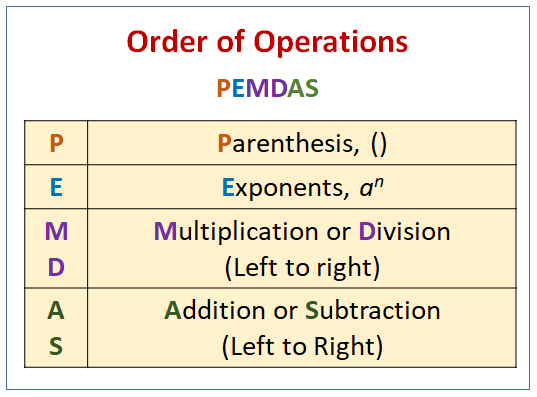Order of Operations - PEMDAS
Related Pages
Order Of Operations PEMDAS
Order Of Operations Worksheet
In these lessons, we will learn the PEMDAS rule for the order of operations. PEMDAS is the acronym for Parenthesis, Exponents, Multiplication, Addition and Subtraction. It is a rule used to determine the order of operations in mathematical expressions. Following PEMDAS ensures that calculations are performed correctly and consistently.
What Is The PEMDAS Rule?
PEMDAS is an acronym that stands for Parentheses, Exponents, Multiplication and Division, Addition and Subtraction.
If the expression consists of parenthesis, exponents, +, –, × and ÷, then the operations MUST be performed in the following order.
- Always work on the calculations within parenthesis first if any.
- Next, calculate the exponents.
- Then, carry out multiplication or division, working from left to right.
- Lastly, do addition or subtraction, working from left to right.

The following figure shows the PEMDAS order of operations. Scroll down the page for more examples and solutions on how to use the PEMDAS rule for order of operations.

How to apply PEMDAS:
- Parentheses (and Grouping Symbols):
First, simplify any expressions inside parentheses, brackets, or other grouping symbols.
If there are nested parentheses, work from the innermost set outward. - Exponents:
Next, evaluate any exponents (powers). - Multiplication and Division:
Perform multiplication and division from left to right, as they appear in the expression.
This means that if division appears before multiplication when reading left to right, you do the division first. - Addition and Subtraction:
Finally, perform addition and subtraction from left to right, as they appear in the expression.
This means that if subtraction appears before addition when reading left to right, you do the subtraction first.
Order of Operations Worksheets
Practice your skills with the following order of operations worksheets:
Printable & Online Order of Operations Worksheets
The order to perform combined operations is called the PEMDAS rule.
Note: Another way to remember PEMDAS is to remember the phrase
Please Excuse My Dear Aunt Sally.
Example:
Evaluate 10 ÷ 2 + 12 ÷ 2 × 3
Solution:
Using the PEMDAS rule, we need to evaluate the division and multiplication before subtraction and addition. It is recommended that you put in parenthesis to remind yourself the order of operation.
10 ÷ 2 + 12 ÷ 2 × 3
= (10 ÷ 2) + (12 ÷ 2 × 3)
= 5 + 18
= 23
How does PEMDAS work?
The following videos show more examples of the application of PEMDAS.
Example:
7 + 3 × 5 =
7 + 3 × 4 ÷ 2 − 5 × 6 =
How to solve order of operations problems?
A more complicated example for the order of operations.
Example:
7 × 2 + (7 + 3 × (5 − 2)) − 4 × 2 =
Order of Operations (PEMDAS)
Examples:
3 + 4 × 5 =
4 × 32 =
[4 − 1 + (5 + 3)] =
15 − 12 × 2/(12/3) + 22=
(2 + 6)/4 × 3
PEMDAS Song (with lesson) order of operations
Examples:
5 × 3 + 5 =
4 + 52 - 2 × (6 ÷ 2)
How to use the PEMDAS rule
Learn one of the most important rules of math: the order of operations, also known as the PEMDAS rule.
Examples:
32 + (8 − 3) × 4 =
8 + 2 × 4 =
24 − 8 × (2 + 3)
3(5 + 8) - 22/4 + 3
39 - 4/4 + 3
Important Notes:
- Multiplication and division have equal priority, so you perform them from left to right.
- Addition and subtraction also have equal priority, so you perform them from left to right.
- PEMDAS helps avoid ambiguity and ensures consistent results.
- Some people use the phrase “Please Excuse My Dear Aunt Sally” as a mnemonic device.
Try out our new and fun Fraction Concoction Game.
Add and subtract fractions to make exciting fraction concoctions following a recipe. There are four levels of difficulty: Easy, medium, hard and insane. Practice the basics of fraction addition and subtraction or challenge yourself with the insane level.

We welcome your feedback, comments and questions about this site or page. Please submit your feedback or enquiries via our Feedback page.